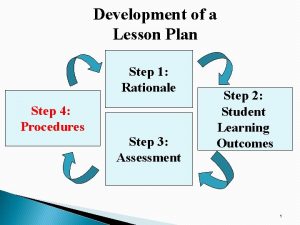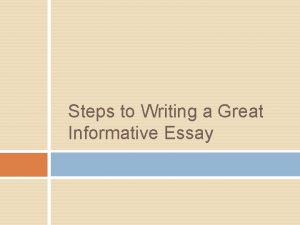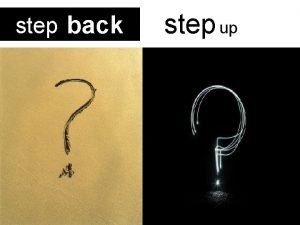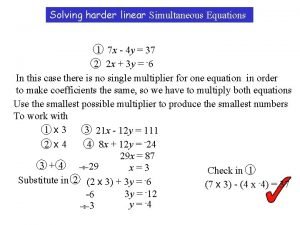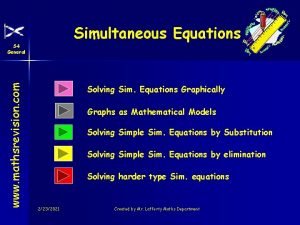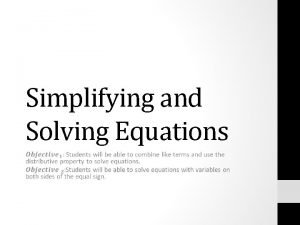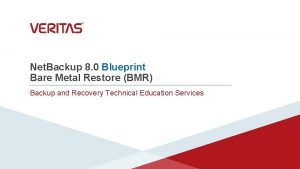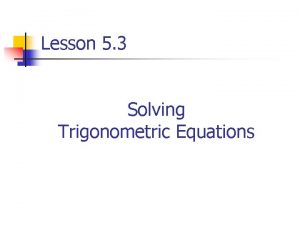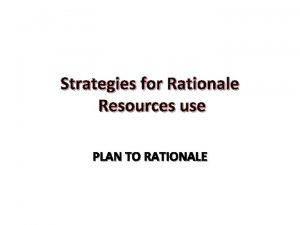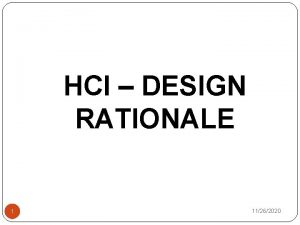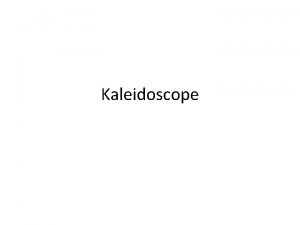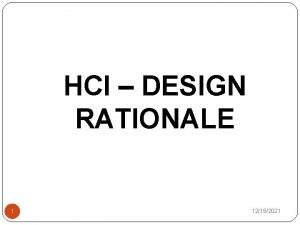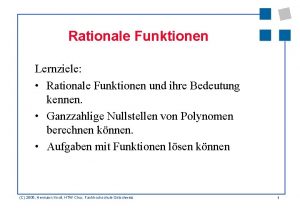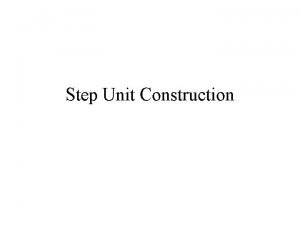Development of a Lesson Plan Step 1 Rationale



















- Slides: 19

Development of a Lesson Plan Step 1: Rationale Step 4: Procedures Step 3: Assessment Step 2: Student Learning Outcomes 1

As a review… You have selected the NGSSS Benchmarks to teach. You have explained 3 reasons why your students should learn the concepts or skills in this lesson – the Rationale. You have designed the specific and measurable objectives that you will teach – the Student Learning Outcomes. You have developed the summative assessment for the lesson – the Assessment. Now, it is time to develop the procedures (instructions) that include the strategies, activities, critical thinking questions, and methods that you will use throughout the lesson to help your students learn and master the student learning outcomes. 2

Procedures step by step instructions that will be performed to teach and master the content of the Student Learning Outcomes 1. List all of the supplies, materials, and equipment that both the teacher and the students will use throughout the lesson. 2. Write the Motivation (or the Set/Springboard) section. - reviews previously taught content - provides an overview of the content to be taught in today’s lesson - uses a “hook” activity to focus student attention, as posing a question or problem or performing a demonstration - aligns with the Student Learning Outcomes 3. Write the step-by-step procedures that will be performed by the teacher to teach the Student Learning Outcomes to the students. - uses a variety of instructional strategies provides a logical sequence checks for understanding stimulates higher-order thinking promotes learning through multiple pathways includes sufficient details (so that the reader could duplicate the lesson activities) 3

Procedures 4. Design questions that will be used to formatively assess the students’ mastery of the content throughout the lesson. - includes at least 3 critical thinking questions that reflect the levels of thinking from Bloom’s highest three levels: analysis, synthesis, and evaluation. 5. Create a review of the concepts/content. - includes an activity or questions that will provide the teacher an opportunity to make sure that each student has mastered the content in the lesson - provides an overview of the next topic 6. Evaluate the student’s mastery of the student learning outcomes using a performance assessment. 4

Procedures Explain the accommodations or modifications that you will use with two of these students: (Include this section of the Procedures only in the EDF 2085 course: see strategies for accommodations in the folders for Week 11. ) - ESOL Auditory learner Visual learner Student from a non-western culture Dyslexic student Tactile-kinesthetic learner 5

Example of a Lesson Plan (Rationale, Student Learning Outcomes, Assessment, Procedures) Ø Identifying Information - Teacher: Mr. Fields Grade level: 4 Subject area (or course: Mathematics Title: “How Steep is Your Skateboard Ramp? ” Ø Next Generation Sunshine State Standards - MA. 4. G. 5. 1: Classify angles of two-dimensional shapes using benchmark angles (45º, 90º, 180º, and 360º). 6

Example of a Lesson Plan (Rationale, Student Learning Outcomes, Assessment, Procedures) Ø Rationale - In this mathematics lesson, students will demonstrate that a protractor is a tool used to measure and draw angles. - Students will learn to draw angles of 45, 90, 180, 270, and 360 degrees and classify these angles as acute, obtuse, right, and straight angles. - Students will relate 2 -dimensional angles of 45, 90, 180, 270, and 360 degrees to real-life 3 -dimensional items to help with problem solving. Ø Student Learning Outcomes - Given a set of degree measurements, the student will use a protractor to draw and classify the angle, scoring at least 80 points on the performance assessment rubric. - Given a set of angles, the student will match the 2 -dimensional drawing to a 3 dimensional object, scoring at least 80 points on the performance assessment rubric. 7

Example of a Lesson Plan (Rationale, Student Learning Outcomes, Assessment, Procedures) Summative Performance Assessment: During this performance-based assessment, the student will draw and label 45, 90, 180, 270, and 360 degree angles. Angles should, also, be classified as acute, obtuse, right, and straight. The student will then be asked to identify common items in the classroom and match each item with the type of angle(s). The student will be expected to complete this performance assessment with at least 80% accuracy, using the Rubric. 8

Example of a Lesson Plan (Rationale, Student Learning Outcomes, Assessment, Procedures) Criteria Superior 25 points each Satisfactory 20 points each Poor 15 points each Accuracy of angles in degrees The student will draw all angles that are accurate to within 5º. The student will draw all angles to within 10º of stated size. The student will draw angles to within 10º in less than 4 out of 5 attempts. Ability to correctly label the angle with the name of the angle at the vertex The student will correctly label all three points of the angle in 4 out of 5 attempts. The student will correctly label all three points of the angle in less than 4 out of 5 attempts. Classification of angles The student will classify angles as acute, obtuse, straight, or right in 4 out of 5 attempts. The student will classify angles as acute, obtuse, straight, or right in less than 4 out of 5 attempts. The student will match the angles with a realworld object in less than 4 out of 5 attempts. Identification of angle with a realworld object TOTAL POINTS 9

Example of a Lesson Plan (Rationale, Student Learning Outcomes, Assessment, Procedures) Scoring Guide Superior: 90 -100 points Satisfactory: 70 -89 points Poor: less than 70 points Points 90 -100 80 -89 70 -79 60 -69 < 60 Grade A B C D F 10

Example of a Lesson Plan (Rationale, Student Learning Outcomes, Assessment, Procedures) Materials/Resources ◦ ◦ ◦ Graph paper Protractors Pencils Rulers Smartboard or overhead projector Motivation (set/springboard) ◦ “Have you ever thought about why some skateboard ramps are very steep while others are so low that you are unable to pick up enough speed to complete difficult tricks? It has to do with the size of an angle. Today we will learn to use a protractor so that we may draw angles, just like the angles that make up your skateboard ramps. ” 11

Example of a Lesson Plan (Rationale, Student Learning Outcomes, Assessment, Procedures) Lesson Procedures 1. Using a Smartboard or overhead projector, begin the explicit instruction portion of the lesson by displaying a protractor and explaining that it is a tool that is used to measure and draw angles. Bring attention to the degrees scale by showing that numbers range from 0 to 180 and 180 to 0. 2. Begin by drawing a ray, using a ruler. Label the endpoint A and another point B. Place the protractor so that the cut-out hole is over the endpoint of the ray and the 0 to 360 degree mark on the protractor is over the endpoint of the ray. 3. Find the 90˚mark on the protractor and place at point C. 4. Use your ruler to draw ray AC. 12

Example of a Lesson Plan (Rationale, Student Learning Outcomes, Assessment, Procedures) Lesson Procedures (continued) 5. Explain that the measure of angle CAB is 90˚, which is also known as a right angle. This angle may also be named angle BAC or angle B, because the vertex names the angle. 6. Place the protractor over the angle, and point out that the 90˚mark is shown on both the 0 to 180 degree and 180 to 0 degree scales. 7. In a Think Aloud, ask yourself, “What might be the reason for 90 degrees to be at the same place for both degree scales? ” This will allow students to observe cognitive reasoning through modeling during the Think Aloud. 8. Direct the students to draw a right angle on graph paper, using a ruler and protractor. Guide students through this process, reminding students that the vertex names the angle. 13

Example of a Lesson Plan (Rationale, Student Learning Outcomes, Assessment, Procedures) Lesson Procedures (continued) 9. Using the Smartboard or overhead projector, draw an angle with a measure of 360 degrees. Draw a ray and label the endpoint J and another point on the ray K. Place the protractor so that the middle of the cut-out is over the endpoint of the ray. Find the 0˚mark on the protractor and place a point labeled L. Draw a circle around the vertex and label the angle at 360 degrees. Point out that the 360 degrees is one full revolution around a circle and that the angle begins and ends at the same point. 10. Continue modeling the process of drawing 45, 180, and 270 degree angles. 14

Example of a Lesson Plan (Rationale, Student Learning Outcomes, Assessment, Procedures) Lesson Procedures (continued) 11. Label each as acute, straight, and obtuse respectively. After drawing and discussing each angle, guide and assist the students through drawing and labeling angles. 12. Once all students have had the opportunity to draw 45, 90, 180, 270, and 360 degree angles, begin a discussion of reallife representations of these angles. For example, the corner of the room represents a 90 degree angle. 13. Find and discuss additional examples of angles in the c classroom. 15

Example of a Lesson Plan (Rationale, Student Learning Outcomes, Assessment, Procedures) Critical Thinking Questions 1. Why do the numbers on the protractor go from both 0˚ to 180˚ and from 180 to 0? (analysis) 2. If the scale on the protractor only goes from 0˚ to 180˚, how do you create a circle that measures 360˚? (synthesis) 3. Other than skateboard ramps, what are additional items that would require the measurement of angles in order to build the structure? (evaluation) 16

Example of a Lesson Plan (Rationale, Student Learning Outcomes, Assessment, Procedures) Closure/Review 1. Today we have discussed how to use a protractor to draw and classify angles. You were able to identify these angles in real-life situations. So, the next time that you zoom down a skateboard ramp, remember that the engineer used his/her protractor to determine the steepness of the ramp. 2. Now, work with a partner to identify at least three different types of angles in the classroom. 17

Example of a Lesson Plan (Rationale, Student Learning Outcomes, Assessment, Procedures) Summative Assessment Use the performance assessment project and its scoring rubric. 18

Lesson Plan Process Procedures - Summary Curriculum - Assessment – Instruction Curriculum: § The NGSSS Benchmarks have been selected. § The Rationale has been developed. § The Student Learning Outcomes have been created. Assessments: § Formative: to check each student’s understanding of the content concepts throughout the lesson § Summative: to check each student’s mastery of the content Procedures: the step-by-step process of activities, strategies, critical thinking questions, and instructions that guide the teacher and students throughout the lesson 19
 Step 1 step 2 step 3 step 4
Step 1 step 2 step 3 step 4 Rationale for lesson plan
Rationale for lesson plan Lesson plan rationale example
Lesson plan rationale example Microteaching lesson plan examples
Microteaching lesson plan examples Six step lesson plan
Six step lesson plan Mda technique
Mda technique Creating a dinosaur sculpture step by step
Creating a dinosaur sculpture step by step What is the first step in writing an informative essay
What is the first step in writing an informative essay Persuasive essay sentence starters
Persuasive essay sentence starters Step up step back
Step up step back How to factor equations
How to factor equations Hardest simultaneous equations
Hardest simultaneous equations Simultaneous equations step by step
Simultaneous equations step by step Simplifying and solving equations
Simplifying and solving equations The process of photosynthesis step by step
The process of photosynthesis step by step Matlab particle filter example
Matlab particle filter example Real application testing
Real application testing Netbackup bare metal restore boot server service
Netbackup bare metal restore boot server service 5-3 solving trigonometric equations
5-3 solving trigonometric equations Sophia loren face shape
Sophia loren face shape

